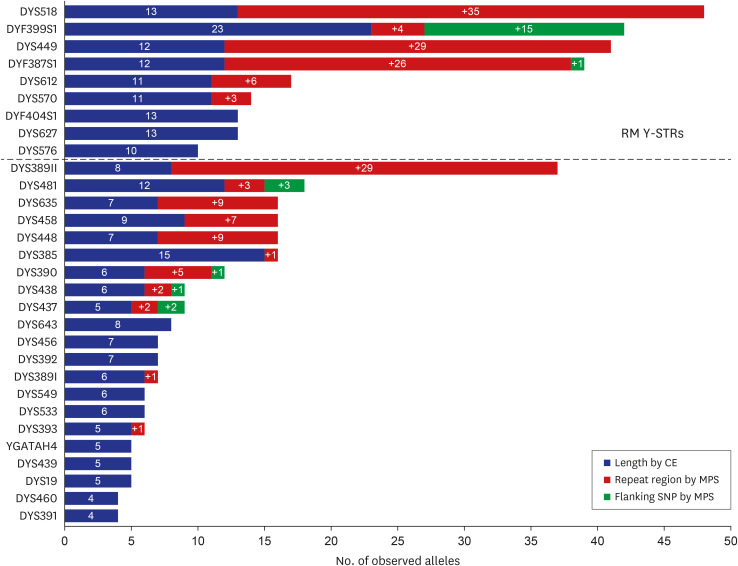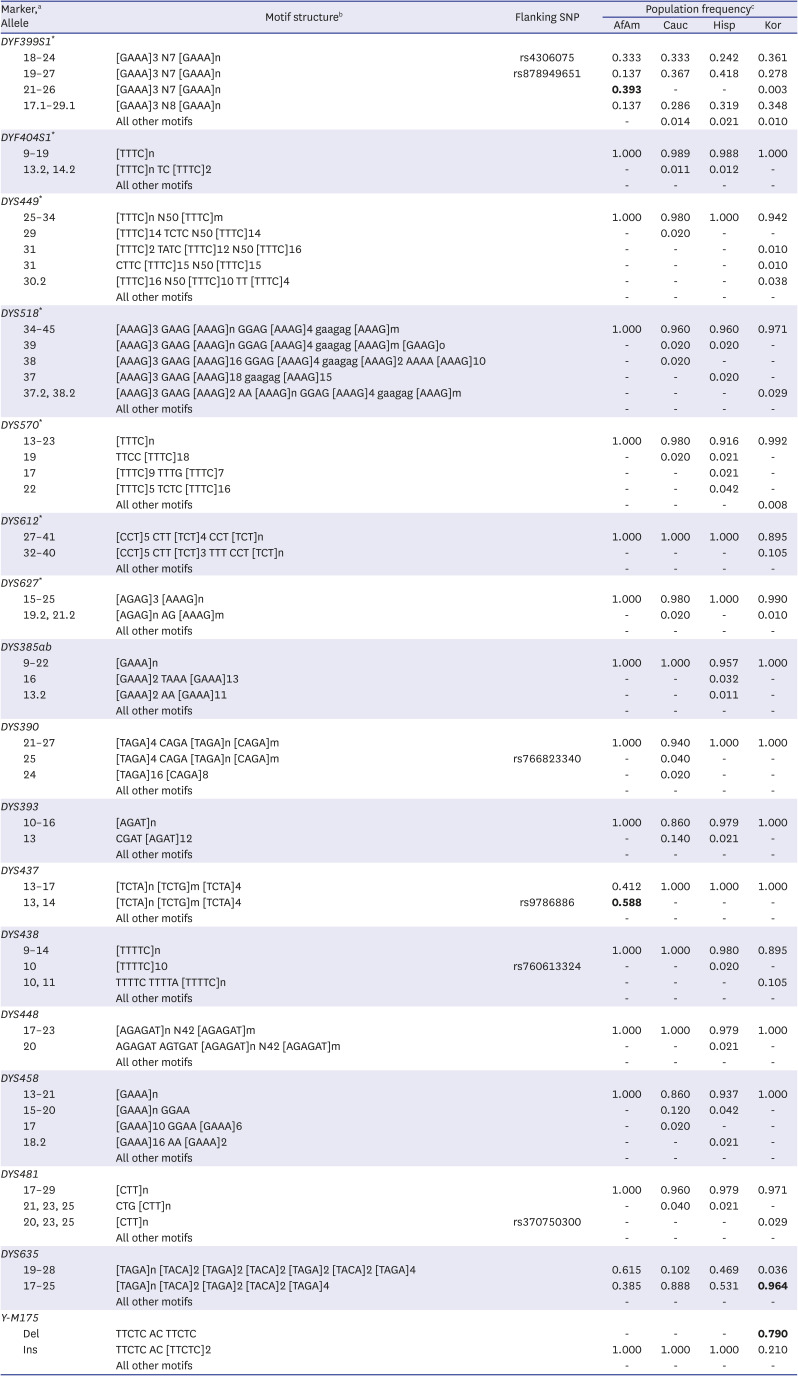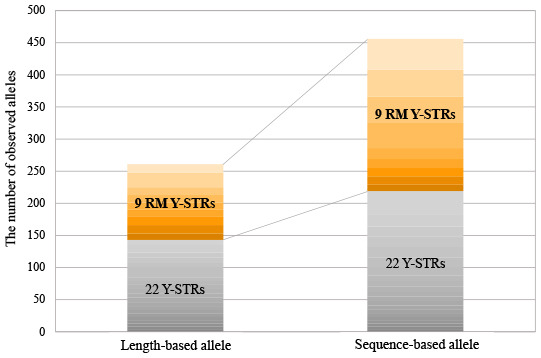1. de Knijff P, Kayser M, Caglià A, Corach D, Fretwell N, Gehrig C, et al. Chromosome Y microsatellites: population genetic and evolutionary aspects. Int J Legal Med. 1997; 110(3):134–149. PMID:
9228564.
2. Jobling MA, Pandya A, Tyler-Smith C. The Y chromosome in forensic analysis and paternity testing. Int J Legal Med. 1997; 110(3):118–124. PMID:
9228562.
3. Jobling MA, Tyler-Smith C. The human Y chromosome: an evolutionary marker comes of age. Nat Rev Genet. 2003; 4(8):598–612. PMID:
12897772.
4. Ballantyne KN, Goedbloed M, Fang R, Schaap O, Lao O, Wollstein A, et al. Mutability of Y-chromosomal microsatellites: rates, characteristics, molecular bases, and forensic implications. Am J Hum Genet. 2010; 87(3):341–353. PMID:
20817138.
5. Ballantyne KN, Keerl V, Wollstein A, Choi Y, Zuniga SB, Ralf A, et al. A new future of forensic Y-chromosome analysis: rapidly mutating Y-STRs for differentiating male relatives and paternal lineages. Forensic Sci Int Genet. 2012; 6(2):208–218. PMID:
21612995.
6. Ballantyne KN, Ralf A, Aboukhalid R, Achakzai NM, Anjos MJ, Ayub Q, et al. Toward male individualization with rapidly mutating Y-chromosomal short tandem repeats. Hum Mutat. 2014; 35(8):1021–1032. PMID:
24917567.
7. Bredemeyer S, Roewer L, Willuweit S. Next generation sequencing of Y-STRs in father-son pairs and comparison with traditional capillary electrophoresis. Forensic Sci Res. Forthcoming. 2021; DOI:
10.1080/20961790.2021.1898078.
8. Alghafri R, Goodwin W, Ralf A, Kayser M, Hadi S. A novel multiplex assay for simultaneously analysing 13 rapidly mutating Y-STRs. Forensic Sci Int Genet. 2015; 17:91–98. PMID:
25884342.
9. Adnan A, Ralf A, Rakha A, Kousouri N, Kayser M. Improving empirical evidence on differentiating closely related men with RM Y-STRs: a comprehensive pedigree study from Pakistan. Forensic Sci Int Genet. 2016; 25:45–51. PMID:
27497645.
10. Park MJ, Lee HY, Chung U, Kang SC, Shin KJ. Y-STR analysis of degraded DNA using reduced-size amplicons. Int J Legal Med. 2007; 121(2):152–157. PMID:
17106735.
11. Fattorini P, Previderé C, Carboni I, Marrubini G, Sorçaburu-Cigliero S, Grignani P, et al. Performance of the ForenSeq
TM DNA Signature Prep kit on highly degraded samples. Electrophoresis. 2017; 38(8):1163–1174. PMID:
28078776.
12. Müller P, Sell C, Hadrys T, Hedman J, Bredemeyer S, Laurent FX, et al. Inter-laboratory study on standardized MPS libraries: evaluation of performance, concordance, and sensitivity using mixtures and degraded DNA. Int J Legal Med. 2020; 134(1):185–198. PMID:
31745634.
13. Churchill JD, Schmedes SE, King JL, Budowle B. Evaluation of the Illumina
® Beta Version ForenSeq™ DNA Signature Prep Kit for use in genetic profiling. Forensic Sci Int Genet. 2016; 20:20–29. PMID:
26433485.
14. Gettings KB, Borsuk LA, Steffen CR, Kiesler KM, Vallone PM. Sequence-based U.S. population data for 27 autosomal STR loci. Forensic Sci Int Genet. 2018; 37:106–115. PMID:
30144646.
15. Huszar TI, Jobling MA, Wetton JH. A phylogenetic framework facilitates Y-STR variant discovery and classification via massively parallel sequencing. Forensic Sci Int Genet. 2018; 35:97–106. PMID:
29679929.
16. Kim SY, Lee HC, Chung U, Ham SK, Lee HY, Park SJ, et al. Massive parallel sequencing of short tandem repeats in the Korean population. Electrophoresis. 2018; 39(21):2702–2707. PMID:
30084488.
17. Kwon SY, Lee HY, Kim EH, Lee EY, Shin KJ. Investigation into the sequence structure of 23 Y chromosomal STR loci using massively parallel sequencing. Forensic Sci Int Genet. 2016; 25:132–141. PMID:
27591816.
18. Kwon YL, Kim BM, Lee EY, Shin KJ. Massively parallel sequencing of 25 autosomal STRs including SE33 in four population groups for forensic applications. Sci Rep. 2021; 11(1):4701. PMID:
33633141.
19. Phillips C, Devesse L, Ballard D, van Weert L, de la Puente M, Melis S, et al. Global patterns of STR sequence variation: sequencing the CEPH human genome diversity panel for 58 forensic STRs using the Illumina ForenSeq DNA Signature Prep Kit. Electrophoresis. 2018; 39(21):2708–2724. PMID:
30101987.
20. Purps J, Siegert S, Willuweit S, Nagy M, Alves C, Salazar R, et al. A global analysis of Y-chromosomal haplotype diversity for 23 STR loci. Forensic Sci Int Genet. 2014; 12(100):12–23. PMID:
24854874.
21. Woerner AE, King JL, Budowle B. Fast STR allele identification with STRait Razor 3.0. Forensic Sci Int Genet. 2017; 30:18–23. PMID:
28605651.
22. Lee EY, Lee HY, Kwon SY, Oh YN, Yang WI, Shin KJ. A multiplex PCR system for 13 RM Y-STRs with separate amplification of two different repeat motif structures in DYF403S1a. Forensic Sci Int Genet. 2017; 26:85–90. PMID:
27816850.
23. Phillips C, Gettings KB, King JL, Ballard D, Bodner M, Borsuk L, et al. “The devil’s in the detail”: release of an expanded, enhanced and dynamically revised forensic STR sequence guide. Forensic Sci Int Genet. 2018; 34:162–169. PMID:
29486434.
24. Novroski NM, King JL, Churchill JD, Seah LH, Budowle B. Characterization of genetic sequence variation of 58 STR loci in four major population groups. Forensic Sci Int Genet. 2016; 25:214–226. PMID:
27697609.
25. Watahiki H, Fujii K, Fukagawa T, Mita Y, Kitayama T, Mizuno N. Polymorphisms and microvariant sequences in the Japanese population for 25 Y-STR markers and their relationships to Y-chromosome haplogroups. Forensic Sci Int Genet. 2019; 41:e1–e7. PMID:
30948258.
26. Park MJ, Lee HY, Yang WI, Shin KJ. Understanding the Y chromosome variation in Korea--relevance of combined haplogroup and haplotype analyses. Int J Legal Med. 2012; 126(4):589–599. PMID:
22569803.
27. Lang M, Liu H, Song F, Qiao X, Ye Y, Ren H, et al. Forensic characteristics and genetic analysis of both 27 Y-STRs and 143 Y-SNPs in Eastern Han Chinese population. Forensic Sci Int Genet. 2019; 42:e13–e20. PMID:
31353318.
28. Yin C, Su K, He Z, Zhai D, Guo K, Chen X, et al. Genetic reconstruction and forensic analysis of Chinese Shandong and Yunnan Han populations by co-analyzing Y chromosomal STRs and SNPs. Genes (Basel). 2020; 11(7):743.







 PDF
PDF Citation
Citation Print
Print




 XML Download
XML Download